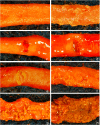The successful experimental induction of necrotic enteritis in chickens by Clostridium perfringens: a critical review
- PMID: 23101966
- PMCID: PMC3546943
- DOI: 10.1186/1297-9716-43-74
The successful experimental induction of necrotic enteritis in chickens by Clostridium perfringens: a critical review
Abstract
Necrotic enteritis (NE) is one of the most important enteric diseases in poultry and is a high cost to the industry worldwide. It is caused by avian-specific, Necrotic Enteritis Beta toxin (NetB)-producing, strains of Clostridium perfringens that also possess in common other virulence-associated genes. In Europe the disease incidence has increased since the ban on in-feed "growth promoting" antibiotics. Because of this, many recent studies of NE have focused on finding different ways to control the disease, and on understanding its pathogenesis. Frustratingly, reproduction of the disease has proven impossible for some researchers. This review describes and discusses factors known to be important in reproducing the disease experimentally, as well as other considerations in reproducing the disease. The critical bacterial factor is the use of virulent, netB-positive, strains; virulence can be enhanced by using tpeL- positive strains and by the use of young rather than old broth cultures to increase toxin expression. Intestinal damaging factors, notably the use of concurrent or preceding coccidial infection, or administration of coccidial vaccines, combined with netB-positive C. perfringens administration, can also be used to induce NE. Nutritional factors, particularly feeding high percentage of cereals containing non-starch polysaccharides (NSP) (wheat, rye, and barley) enhance disease by increasing digesta viscosity, mucus production and bacterial growth. Animal proteins, especially fish meal, enhance C. perfringens proliferation and toxin production. Other factors are discussed that may affect outcome but for which evidence of their importance is lacking. The review compares the different challenge approaches; depending on the aim of particular studies, the different critical factors can be adjusted to affect the severity of the lesions induced. A standardized scoring system is proposed for international adoption based on gross rather than histopathological lesions; if universally adopted this will allow better comparison between studies done by different researchers. Also a scoring system is provided to assist decisions on humane euthanasia of sick birds.
Figures


References
-
- Parish WE. Necrotic enteritis in the fowl Gallus gallus domesticus. I. Histopathology of the disease and isolation of a strain of Clostridium welchii. J Comp Patho. 1961;71:377–393. - PubMed
-
- Songer JG, Meer RR. Genotyping of Clostridium perfringens by polymerase chain reaction is a useful adjunct to diagnosis of clostridial enteric disease in animals. Anaerobe. 1996;2:197–203. doi: 10.1006/anae.1996.0027. - DOI
Publication types
MeSH terms
LinkOut - more resources
Full Text Sources
Other Literature Sources

